Back in August 2015 I published some of my father’s photos where I needed help with identifying the location. This week’s post is about one of these locations, which I really should have known, however thanks to many readers it was quickly identified. The following photo was taken in Glamis Road in Wapping, looking towards the Prospect of Whitby pub which is framed by the bridge crossing the entrance to the Shadwell Basin from the River Thames.
The same view today is shown in the photo below. My father was much better at timing photos. When I took the photo below, it was a lovely sunny autumn day, but this meant I was looking into the sun so the lighting is not ideal to bring out the detail. Converting to black and white and adjusting the contrast did help slightly.
Glamis Road crosses the bridge to become Wapping Wall which passes the pub and then meets Garnett Street and Wapping High Street. The area was dominated by the London Docks which were still in operation when my father took the above photo in 1951. As can be seen in the 1951 photo there is still the control cabin for the bridge on the left and directly in front of the bridge on the pavement on the left looks to be some form of illuminated sign which perhaps was the warning sign when the bridge was about to open.
Today’s photo has one of my pet hates – the amount of clutter we have across the streets. Multiple poles with multiple signs. Not sure how long the new road layout has been in place, but I have seen these in place for years after the original change.
The bridge is across the eastern entry from the River Thames to Shadwell Basin which was the eastern end of the London Docks complex.
The map below shows the 19th century configuration of the London Docks and shows how much of Wapping these docks occupied at their fullest extent. Look at Shadwell Basin on the right of the London Docks and there are two channels providing access to and from the Thames. The only one of these channels still in existence is the upper channel and it is this channel that the bridge crosses.
The original part of the London Docks, the Western Docks opened in 1805 and specialised in wine, brandy, tobacco and rice. The docks were a success and over the next couple of decades expanded further east with the Shadwell Basin and eastern entry into the river being the completion of the London Docks complex.
The land on which the Shadwell Basin was built was originally the home of the Shadwell Waterworks Company which had commenced operation in 1669 to provide a water supply to the area east of the Tower of London. Soon after the opening of the Western Docks, the London Dock Company purchased the land and the Shadwell Waterworks Company which maintained operation until water supply was transferred to the East London Waterworks, which then allowed the Shadwell Basin to be built.
If you look above the two channels, the area that is now occupied by the King Edward VII Memorial Park was original the Shadwell Fish Market.
The London Docks closed in 1969 and over the following decades the majority of the docks were filled in. The Shadwell Basin is the only main dock section to survive.
The following photo is looking into Shadwell Basin today. The land on the left is between what was the two channels to the river and was Brussels Wharf, and was occupied by a large shed as can be seen in my father’s photo.
Looking from the bridge along the channel which leads to the Thames. At the end of the channel were the lock gates needed to protect the water level in the docks from the variations of the tidal river. It must have been quite a sight to see the shipping pass through here in the hours when the tide was right, particularly during the days of sail when entry to such a narrow dock entrance was down to mastering the flow of the river and wind. The entrance today is permanently blocked.
Last year, during my trip down the river in the Paddle Steamer Waverley I took the following photo from the river showing the entrance to Shadwell Basin. The bridge can just be seen above the entrance.
The Aerofilms archive provides the perspective needed to understand the layout of the docks. The following photo was taken on the 17th June 1948. Wapping is the land in the lower part of the photo with the Shadwell Basin in the lower centre with the entrance to the river leading to the left. The bridge can be seen with the road running up to where it bends to the right past the Prospect of Whitby.
If you look to the right of Shadwell Basin, there is a channel that leads into the next section of the London Docks on the right. There is a similar bridge over the channel, which is still in existence. This is in Garnet Street.
Back to the original wall and signage on the wall records the names of the Shadwell Basin and Brussels Wharf.
View from the other side of the bridge showing the large counterweight used to balance the road span as the bridge is raised or lowered.
Always on the lookout for murals, I was pleased to see this within a shelter adjacent to the bridge.
At the far end of my father’s original photo was the Prospect of Whitby which claims to be London’s oldest riverside pub dating from around 1520. The pub was originally called The Pelican and the alley and stairs down to the river at the side of the pub to the right are still named Pelican Stairs. The pub was also referred to as the Devil’s Tavern due to the reputation of the pub and the stairs as a haunt for smugglers and thieves. The name changed to the Prospect of Whitby in the late 18th century / early 19th century (I have found multiple years referenced as when the name changed) after a collier of the same name that berthed adjacent to the pub.
I suspect that the original pub may also have been a brewery, or there was an adjacent brewery. A number of newspaper articles reference the Pelican Brewery on Wapping Wall, for example the following from the Public Ledger and Daily Advertiser of the 18th May 1824:
“To Brewers, Publicans, Coopers, and Others, by Mr. Cockerell.
At the Pelican Brewery, Wapping Wall on Thursday, the 20th instant, at Eleven, Lots suitable to the Trade, Publicans, and Coopers, (in consequence of an agreed Dissolution of Partnership). About 550 Barrels of PORTER, STOUT and ALE; four capital Dray Horses, three Drays and Harness; about 850 casks, in Butts, Puncheons, Hog-heads, Barrels, and other, a quantity of Hops and other effects. may be viewed and tasted two days prior to the Sale.”
The area around the Prospect of Whitby must have been a scene of continuous coming and going of ships, cargo, sailors and passengers. There are also advertisements which indicate the type of trade carried on here. Again from the Public Ledger and Daily Advertiser of the 2nd December 1819 there is an advert for the new Brig Rolla which “carries 10 keels of coals at a light draft of water, sails fast, and shifts with all an end; adapted for the Mediterranean or Oporto Trade, or general purposes,; fitted for passengers, copper fastened and fitted with a busthead and quarter badges, also a high quarter deck.”
Researching the Prospect of Whitby provides a glimpse into the life of a docklands pub and landlord.
In June 1861, the landlord, a Mr Isaac who was also the Secretary of a Loan Society was in court to try to resolve a possible complex case of fraud where the recipient of a loan had disappeared, but leaving the person who requested the loan in Wapping to pay back the sum which he could not.
In 1858, the same Mr Isaac welcomed the officers of the East End district of the Ancient Order of Foresters to the Prospect of Whitby for the purpose of opening a new branch of the order. The account of the meeting states that a very large number of members from various courts were present, and there were several toasts given.
For many years in the 19th century, the Prospect of Whitby was part of a sculling regatta on the Thames which appears to have had a rather valuable prize money of a few hundred pounds. In October 1889 it was reported that “Weather of the most dispiriting description was associated with yesterday’s racing in connection with the regatta, which, as on Saturday, was decided on the ebb over the customary course between the Hermitage Wharf and the Prospect of Whitby, Wapping Wall.”
The Prospect of Whitby also claims Samuel Pepys, Charles Dickens, Whistler and Turner as customers. The Prospect of Whitby today:
Pelican Stairs running down the side of the Prospect of Whitby. Just imagine the stories of the number of people who must have passed down this alley on their way to and from ships on the river.
The Prospect of Whitby from the river with Pelican Stairs on the left.
The building immediately behind the Prospect of Whitby which can also be seen in my father’s and my photos of the bridge and pub, is the 1890 building of the London Hydraulic Power Company.
Once again, within the confines of a weekly post I have only just scratched the surface of the history of this area. Wapping is a fascinating area to walk, and rounding off with a drink in the Prospect of Whitby made for a perfect Autumn walk.



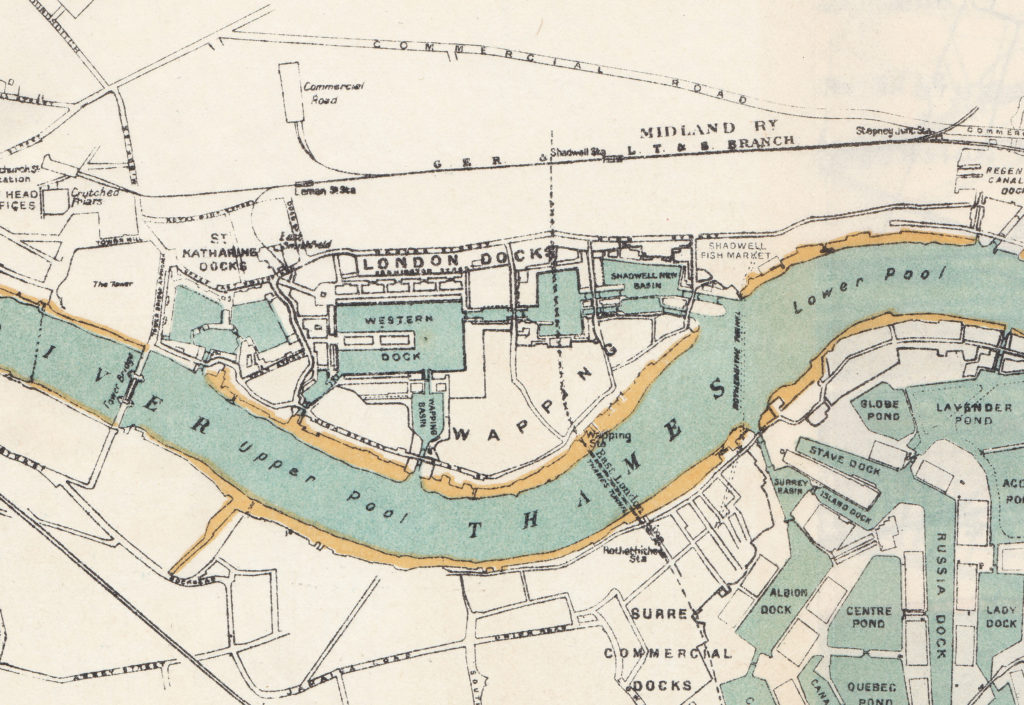

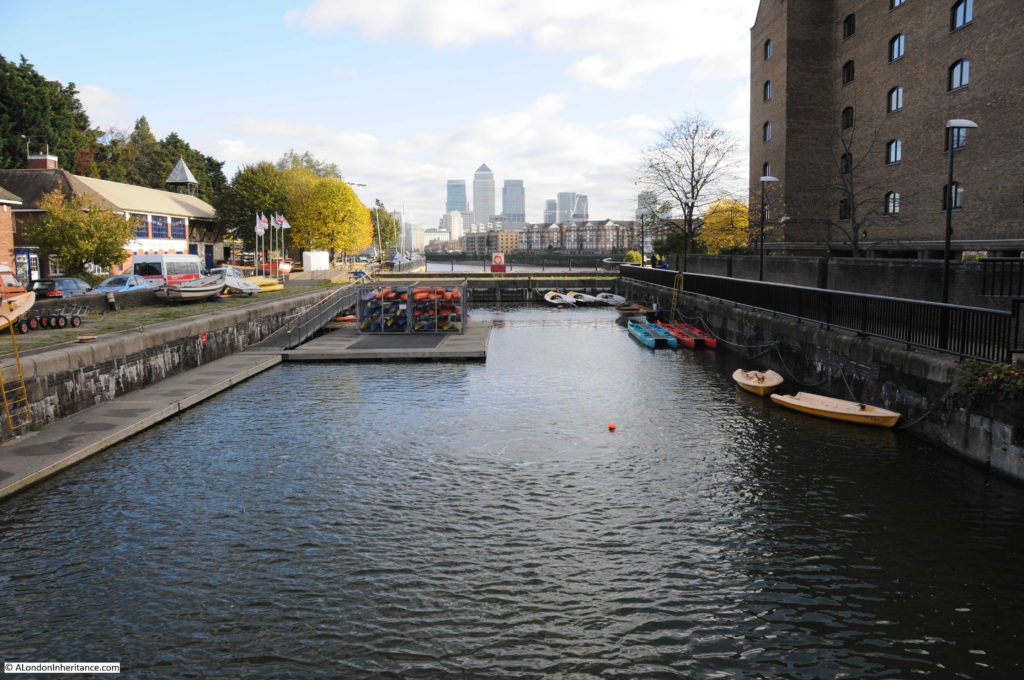
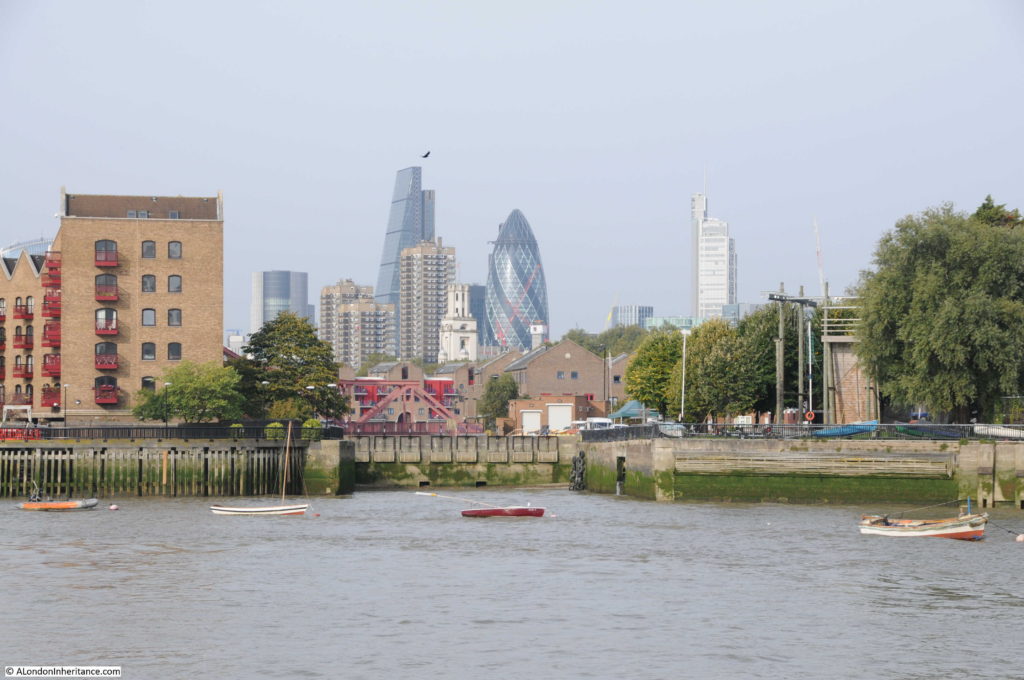
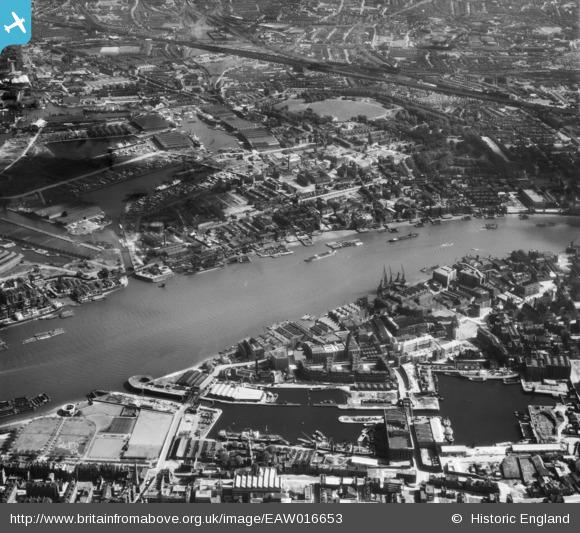
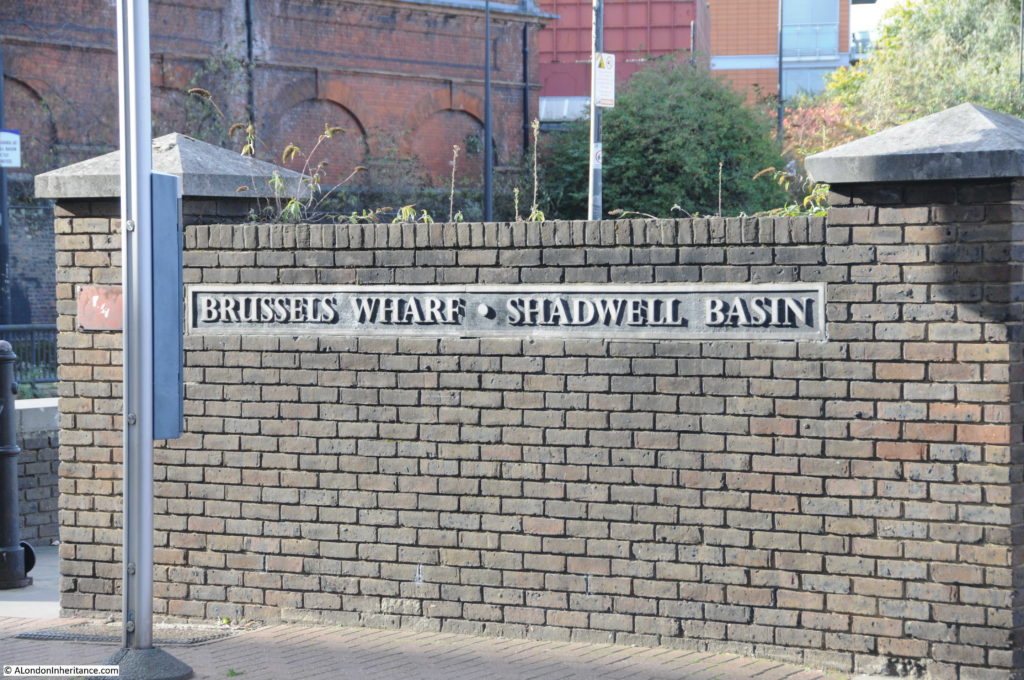

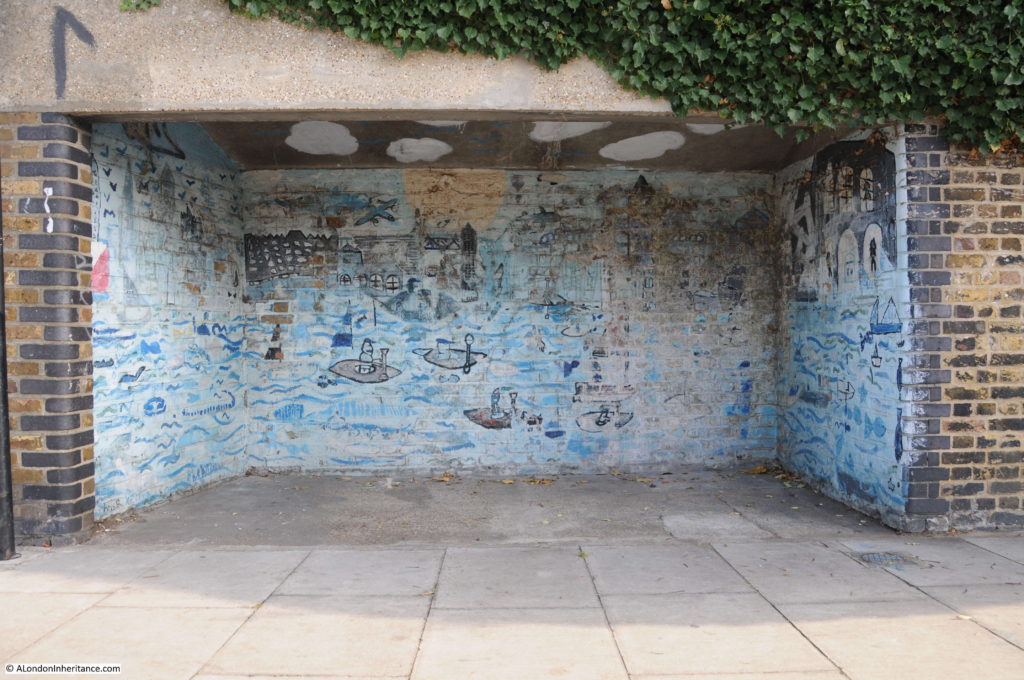

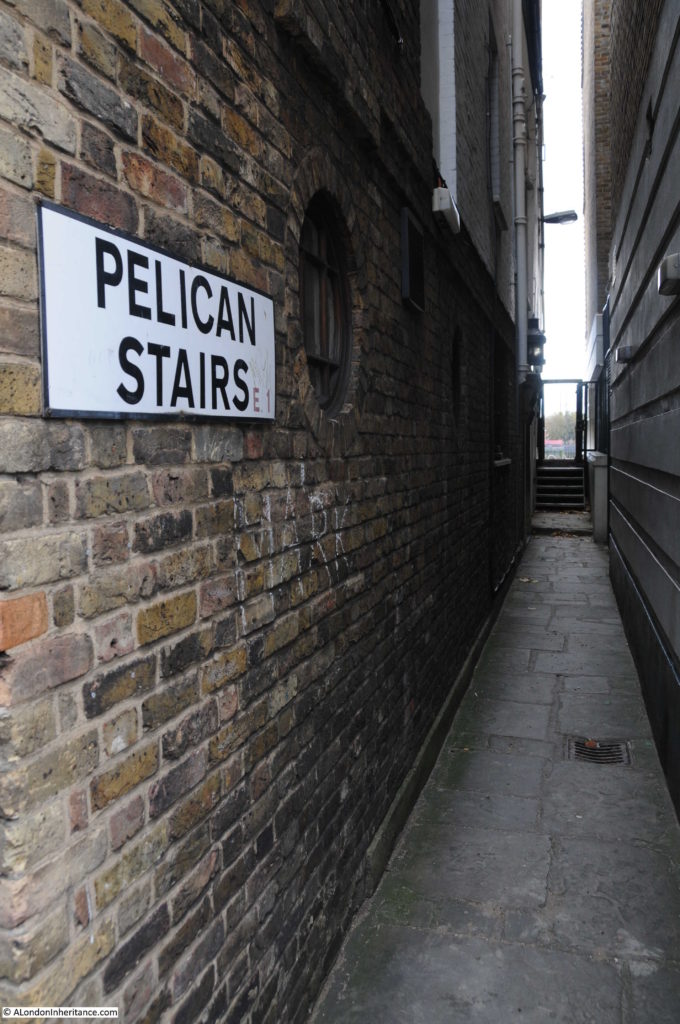
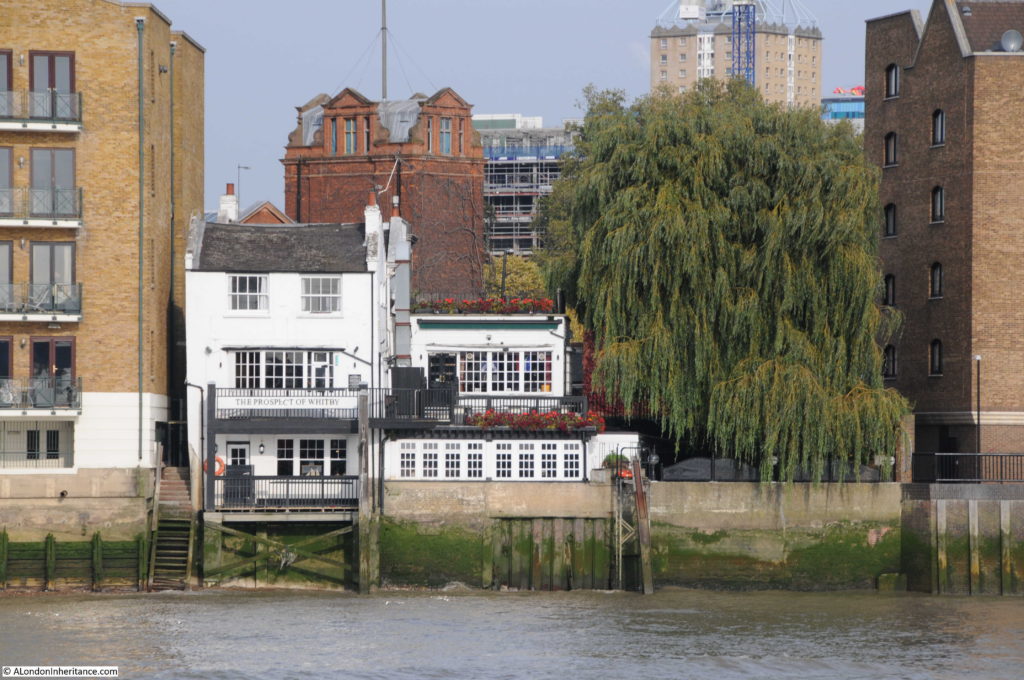
There’s also a similar bridge on the south side of the river too, still there today as well, near the Rotherhithe Tunnel ventilation shaft. It’s a bit hard to make out in the aerial photo you’ve posted, but I assume it must have been there when that photo was taken too.
I wonder what the dockers would have thought back then in its hey-day to know that now Shadwell Basin’s only users today are canoeists, and on hot summer’s days hordes of swimmers!
I too followed this almost same path only a few weeks ago as my forebears lived on The Highway nr St George in the East so I walked down from Aldgate East to Wapping Station and followed the same route as you even climbing down Pelican and New Crane Stairs 🙂 one of my ancestors was born in Old Gravel Lane early 1800’s and they had a shop on The Highway and also lived on what is now the continuation of Cable St nr Devonport St which they also lived in! But as my time was short and heading back to Oz I ended at the corner of Cable & Glamis and only yesterday I discovered that I was almost on the same spot Anyway I’ll be better prepared for next time but I loved my journey through the area and it was a beautiful sunny crisp day!
Back in the 70’s, I walked around this area. I found a pub with an alley leading to a tiny mooring area. I think I had to ask the publican to unlock a gate to access the river but I’m not sure. I was told that it was where convicts were sent off to Oz. I’ve had no luck in finding such a pub as yet but this one is the nearest yet. Are there any other similar pubs, or have I got my wires crossed?
I suspect you’ll never see this answer, 3 years later, but I expect the pub would have been the Town Of Ramsgate, not far from the Prospect. It’s still open and is another old Thameside pub but unfortunately had a ‘revamp’ in the 80’s which probably did it no favours. Some of those convicted and sentenced to transportation where held in the cellars under the pub prior to be loaded on board.
And after being held in the cellars they were taken to Dunbar Wharf in Limehouse where the great majority of those being transported were embarked
The Prospect is a lovely pub for a sit down and a drink in the non-tourist season. The upstairs room has that grand view over the wide and windy river too. With good timing plus luck you can have the room to yourself.
Wapping Station is fascinating with its cramped platforms, narrow staircases and river odour. It wasn’t designed to have two railway lines running through it, and it shows.
I started work has a office boy in Brussels Wharf (Brussels Steamship Co.Ltd ) in 1962, I can remember the bridge being raised for vessels entering and departing mainly to ports in the near continent.
Some of the dockers would have a swift pint at lunch time at the “Prospect”.
I now live in Buckinghamshire but I do visit Shadwell several times a year
Thanks for the wonderful picture of the shadwell basin bridge as it was, my grandfather was a docker, and lived nearby. I used to watch the bridge open for ships back in the 60’s. I haven’t seen a picture of the bridge open and a ship passing through, which is a shame, they must be rare, fantastic memories as a young lad for me.
Hello Brian
Just missed you then – I was 2nd Mate of the ‘City of Brussels’ till ’61, would love to see photo of her if anyone has one.
Best
John.T.
John
I have seen several photographs on the web of the “City of Brussels” it’s a matter of trolling thru the web.
Was Capt Craigh the master ?
Regards
Bryan
Thanks Bryan
In answer to your question – Yes he was.
Will try a troll as suggested.
Was over a couple of weeks ago searching where ‘Gravel Lane’ used to be in Southwark. As Great Grandfather ( by several times) was living there When me married in 1828, still there in 1831, when first daughter died, but then moved across to Clerkenwell, established his coachlamp making business in 1823 in Gravel lane. Uhm does look a bit different now !!
Did on second try find it and followed, just found one pair of houses that might have been there at around that epoch.
Best
John.T
John
Searching your family tree is very time consumming, I am doing the same thing, my great mother was a Russian Jew who married a Welsh man named Jenkins, the latter is causing me problems.
Back to Brussels Steam do you remember the chief engineer Mr Rigg, I met up with his son Dominic sometime ago small world, at the time they lived locally in Sydney Street
Hello Bryan
Photos on web not of our S.S.City of Brussels.
On other subject – Ancestors ! yes, when it came to Wilsons and Millers, I nearly gave up, however there exist a site of helpful people ‘Roots chat.com’, and yes found hundreds of correct Wilsons.
Best
John
John
You located the old City of Brussels, there is a picture of the latter C of B anchored in the Thames prior to entering the locks at Shadwell .
My father was Capt Ewan Craig
I can’t remember how long he was master ofC o B or C o L
But it was quite some time
Roy Rule was first mate
Tommy Johnson was second mate
My brother and I wennt across to Brussels with our mother every year
I still have the clocks that came out of the ship before she went to the greeks
Capt Patton was the maste of C o L
AMC
Alistair
I remember your father, I was an office boy at Brussels Wharf in the early 60’s I can’t remember the name of the first officer, at the the 2nd officer was Bill Prosser, chief engineer Mr Rigg ( I knew his Dominic).
I have details which might be of interest to you:-
This vessels was renamed “Barramilias” port of reg:- Panama
Owners:- Cia.De Navigacao Balti.
1966 vessel renamed “Capitao Bismarck”
1969 Survey Incomplete (Class suspended)
1972 Broken up in Spain
I was told that the C of B was sold for around £ 25,000.00
I did have several meals on board she was a great vessel Happy Days
Bryan
The first mate was Roy Rule, he went on to captain the Havengore for the PLA
The first engineer was John Birchenoff, he would drink a bottle of gin everyday
Riggs was his second engineer
George was the cook
These certainly the Good Days
AMC
Alister
My hobbie is researching British short Sea companies and their vessels, however, the PLA vessel
“Havengore” has some history by taking Sir Winston Churchill from Westminster to Tower Pier for his funeral at St Paul’s.
It might have been possible that Roy Rule was the Master of this vessel at the time ?
We live very near Bletchley Park (Enigma) and understand that a model of the vessel is on display.
Edward Richard Henry was born at 12 Wapping Wall in July 1850 to Irish parents , Dr Alexander & Maria Henry . In 1903 Edward Henry became Commissioner of Police for the Metropolis . In 1901 as Assistant Commissioner for Crime he established within Scotland Yard a Fingerprint Bureau based upon his unique Fingerprint Classification system which spread throughout the western world’s Criminal Investigation Departments…including the USA. Sir Edward resigned from the Metropolitan Police in 1918 and retired to Ascot where he died in 1930.
My grandma (who died before I was borne) was brought up in the Prospect of Whitby, her sister went on to run the Blind Beggar, their name was Williams it would have been 1880 or so when she was borne my great grandfather was a ship carpenter don’t know if he was the landlord or what, she had four sons who all died in the first world war and went on to live in Calverton road East Ham and had 4 more sons by a Mr. Saunders my grandad (also dead before I was borne)
but between this, it is said she was the companion of the ambassador to France, (I think there may well have been many though). I would be interested in anyone who knows more about this family, my dad and his brothers (her sons) used to visit the grandparents there and play on the wooden jetties that are no longer.